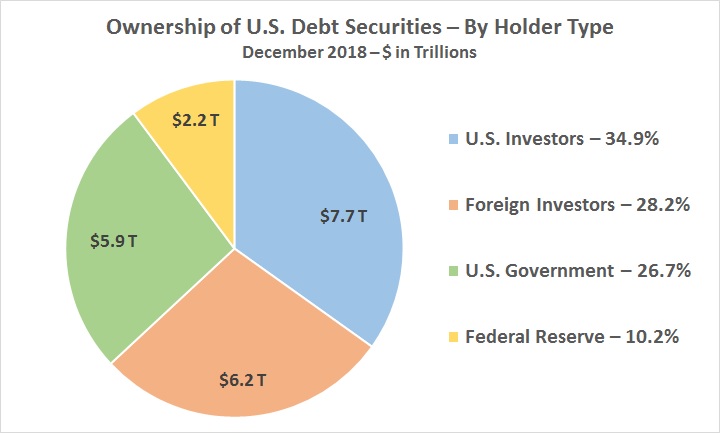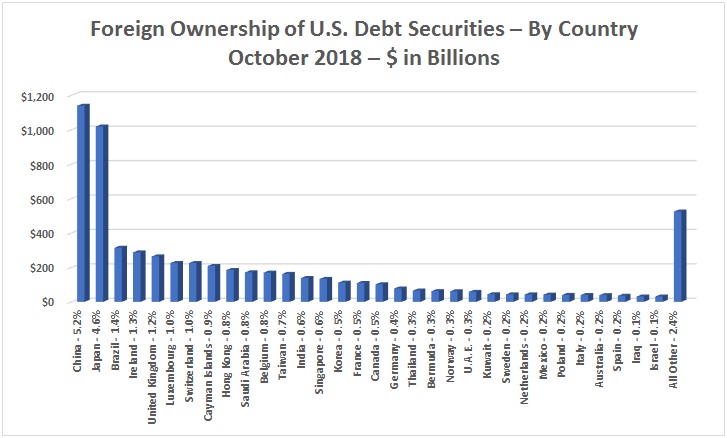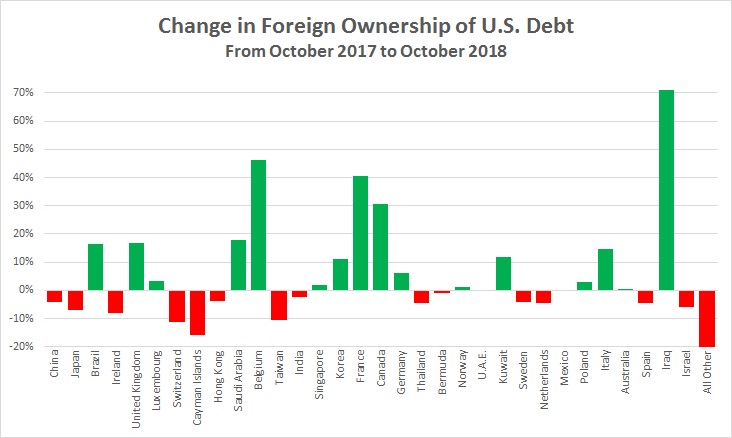
Depending upon what news sources you read, you may have the impression that the vast majority of the official U.S. government debt is held by China and certain other large foreign governments. While it is true that China is the largest foreign holder of U.S. government-issued debt securities, a closer look at the facts presents a different picture.

As of December 31, 2018, there were $21.97 trillion of U.S. government-issued debt securities outstanding. U.S. investors were the largest owners of these securities, holding 34.9%, or $7.7 trillion, of the amount outstanding. These investors represent everything from state pension funds, corporate pension funds, college endowment funds, mutual funds, hedge funds, and corporations on down to small mom-and-pop individual investors.
Behind the U.S. domestic holders, foreign investors held the next largest chunk of our nation’s debt, at 28.2%, or $6.2 trillion. By far, the two largest foreign holders of our debt were China ($1.1 trillion, or 5.2% of our total issuances) and Japan ($1.0 trillion, or 4.6% of our total). It then drops off very quickly, and the third largest foreign holder, Brazil, is at $314 billion, or 1.4% of our total issuances.
Very interesting is the third largest overall holder of U.S. government-issued debt—it is the U.S. government itself. The U.S. government owns 26.7% of itself, at $5.9 trillion of U.S. debt. How is this possible? Any government agency that brings in money, with an expectation of paying it out someday, can decide to invest in U.S. government debt securities, as it could in any other investment security. These agencies include: the Social Security Trust Fund and Federal Disability Insurance Trust Fund (which own about $2.87 trillion), the Office of Personnel Management Retirement Fund ($989 billion), the Military Retirement Fund ($829 billion), and Medicare ($277 billion), among many others. For all the talk about how much U.S. debt China owns…U.S. taxpayers must pay more than 2.5 times that amount back to our national social security system.
And finally, with all the discussion about “quantitative easing,” QE2, QE3, and the “monetization” of our nation’s debt, the Federal Reserve Bank represents the fourth largest category of holders of U.S. government debt issuances. Clocking in at $2.24 trillion worth of U.S. debt holdings, the friendly faces commanding and commandeering the U.S. banking system collectively own 10.2% of our nation’s overall debt. In return, these non-federal commercial institutions (and their private shareholders) reap billions of dollars in interest payments per year for dollar issuances to the U.S. government, which they were able to create based solely upon the full faith and credit of the U.S. government. Now that’s a lucrative gig if you can get it!
Boring in a little on the foreign holders of our nation’s debt, we see China (#1) and Japan (#2) far and above at the top. Note that some observers believe that Luxembourg (#6) and the Cayman Islands (#8) rank so far up the list, not because their nations are shrewd investors with large capital pools to invest, but because certain investors preferring to hide their investing identities choose these countries through which to invest covertly and privately. Perhaps the same can be said for Switzerland (#7). And could Ireland be so high up on the list because it is a chosen tax haven for highly profitable tech firms such as Apple, who direct their profits through this small country because of its tax savings???

Another interesting trend to consider is the change in ownership of U.S. government securities by foreign holders. The threat of China “dumping” its U.S. debt holdings is mentioned at times in the press. While we have seen a 4.2% ($50 billion) reduction in Chinese holdings of U.S. government securities from October 2017 to October 2018, it is by no means a dumping. Japan actually sold more, on a percentage (6.9%) and actual ($76 billion) basis, during this time. Perhaps more interesting are those countries that significantly increased their holdings: Brazil (+16%), United Kingdom (+17%), Saudi Arabia (+18%), Belgium (+46%), France (+40%), Canada (+31%), Kuwait (+12%), Italy (+15%), and Iraq (+71%).

Sources for these various charts include:
The U.S. Treasury Department
The U.S. Treasury Department
The Balance
Wikipedia
And if you want to see just how much the U.S. debt is going up every single day…
Related Reading:
Solari Report 2017 Annual Wrap Up—The State of Our Pension Funds
